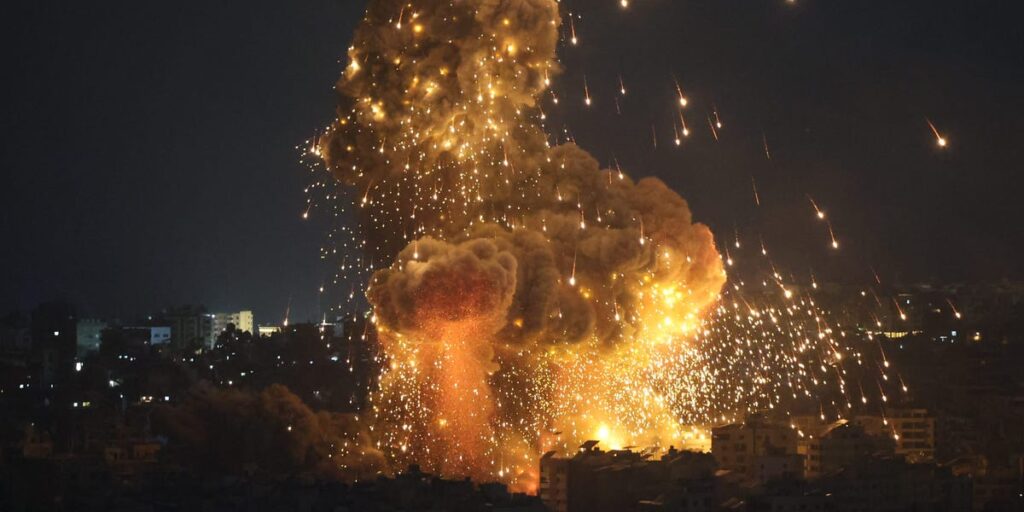- Hamas carried out a devastating attack on Israel one year ago, killing about 1,200 people.
- The terror attack has helped push the Middle East to the brink of a wider regional war.
- Attempts to de-escalate have repeatedly failed, with Israel and Iran getting closer to a conflict.
On the early morning of October 7, 2023, air raid sirens began blaring in Israel, warning its citizens that an attack was in progress.
Hamas, a militant group much of the West has designated a terrorist organization, launched a highly coordinated strike that the Israel Defense Forces would later say killed about 1,200 people.
One year after the massacre, the Middle East has only plunged deeper into violence and is on the brink of a broader war.
Paths to de-escalation, largely facilitated by the US, have repeatedly failed. And Israel appears to be inching closer to a direct conflict with Iran, a grim prospect that has been avoided for years as the two countries limited their fight to proxies in a shadow war.
The results of the yearlong conflict, with origins that date back decades, have been costly for Israel and the entire Axis of Resistance, Chuck Frielich, a former deputy national security advisor who served for over 20 years in Israel’s security establishment, told Business Insider.
“Israel has turned the tide and has the Axis of Resistance on the defensive. Hamas has been defeated militarily, though not politically, and remains in political control in Gaza,” Frielich said, adding that Iran is now in a vulnerable position.
“Conversely, Israel was in the midst of a multi-front war which may result in significant damage to its homefront and is deeply isolated in the world,” he added.
A year of bloodshed
Israel’s response to Hamas’ attack on October 7 was a massive bombardment campaign and later ground incursion in Gaza, which Palestinian authorities say have left about 42,000 people dead.
Amid the early stages of that campaign, the first high-profile expansion of the greater conflict blew open in late October, when Yemen’s Houthi rebels began attacking commercial ships seeking passage through the Suez Canal and the Gulf of Aden.
The Houthis, historically backed and armed by Iran, said they were declaring a show of support for Hamas by attacking ships linked to Israel, though they were often found to have used drones, missiles, and raiding parties to harass vessels with no direct relation to it.
With the Houthi attacks threatening to close off a vital international shipping lane, the US and its allies and partners established a heavy military presence in the Red Sea to fend off the rebels.
January saw the West’s most direct and overt military involvement in the conflict, when the US, UK, and their allies barraged Houthi targets with airborne, surface, and subsurface-launched strikes after warning the rebels repeatedly to cease their attacks.
The campaign has dragged on for almost a year with no end in sight, and the US has been rotating multiple aircraft carrier groups into the region while carrying out further strikes on Houthi territory.
To the north, Syria became the site of further conflict in April, when Israel launched a strike on the Iranian consulate in Damascus, killing several senior officials of the Iranian Revolutionary Guard Corps, including two generals.
Farzin Nadimi, a senior fellow at The Washington Institute for Near East Policy, previously told BI that the strike was significant because it was the “first time Israel struck an official Iranian government-affiliated site with high-ranking people inside.”
Iran followed up with a long-range attack on Israel at an unprecedented scale, launching what Israeli authorities said were 170 attack drones, 120 ballistic missiles, and 30 cruise missiles — almost all of which were intercepted.
Israel then responded with its own strikes on multiple cities in Iran. And in July, Ismail Haniyeh, the political leader of Hamas, was killed just after he attended the swearing-in of Iran’s new president.
Haniyeh was widely reported to have been killed by a remotely detonated explosive device that was planted months before his death in a guesthouse he was using in Tehran.
Israel also claimed responsibility that week for killing top Hezbollah commander Fuad Shukr, a senior advisor to the Lebanese militant organization’s secretary-general Hasan Nasrallah, via an air-launched strike in Beirut.
Meanwhile, Hezbollah, a longtime enemy of Israel, has been exchanging fire with Israel on its southern border since the October 7 attack, forcing hundreds of thousands of civilians on both sides to flee.
In one of the most dramatic attacks the region has yet seen, thousands of pagers and communication devices used by Hezbollah detonated in September, injuring more than 2,800 people and killing at least eight.
Mossad, Israel’s spy agency, is widely believed to have orchestrated the attack by planting explosives inside the devices before they were distributed, but Israel has not claimed responsibility.
At the start of this month, Israel began what it called a limited ground incursion into Lebanon, saying it aimed to dismantle Hezbollah’s positions and artillery in the south.
It’s unclear if Israel plans to expand its scope in Lebanon, where it faces difficult terrain and Hezbollah troops who have had years to embed and prepare.
Meanwhile, Lebanon’s health ministry said more than 2,000 people have been killed so far in the ensuing strikes and raids.
Days after starting its ground incursion, Israel followed up with a strike that killed Nasrallah at Hezbollah’s headquarters in Beirut, bringing an end to his 32-year leadership of the militant group.
Iran moved hours later to launch a second missile attack on Israel.
Tehran is reported to have fired about 200 missiles at Israel on October 2, including its advanced Fattah missile capable of reaching speeds of Mach-5.
Escalations don’t bode well for the Middle East
History shows there’s little chance that Israel will let that attack pass without a response, as Israel’s Prime Minister Benjamin Netanyahu indicated in a speech to the United Nations General Assembly on September 27.
“If you strike us, we will strike you. There is no place in Iran that the long arm of Israel cannot reach, and that’s true of the entire Middle East,” he said.
Meanwhile, last month saw hundreds of thousands of Israeli protesters rallying against Netanyahu’s failure to secure some sort of cease-fire deal that could lead to the release of the hostages remaining in Gaza after the attack one year ago.
Gili Roman, whose sister was kidnapped on October 7 and later released and whose relative Carmel Gat was among the six slain hostages recovered by the IDF in early September, told BI last month that Netanyahu and his government were “prioritizing themselves” over the hostages.
The anticipation of yet another cycle of escalating retaliation has set the world on edge, amid fears that an all-out war between Iran and Israel will destabilize the entire region.
Globally, the immediate concern is that oil supplies will diminish significantly should conflict spill over to the rest of the Middle East.
Last week, Citigroup analysts estimated that a major strike on Iranian oil infrastructure could reduce global oil supplies by 1.5 million barrels per day.
Israel ignores US red lines
US President Joe Biden has for a year been trying to avoid the war growing into a wider regional conflict that could pull in the US and other world powers.
He has repeatedly sought to broker a cease-fire in Gaza, organize more humanitarian support for civilians, and limit Israel’s campaign.
But Netanyahu has repeatedly ignored Biden’s red lines and has continued to push forward against Hamas even as the civilian death toll spiraled and international opposition to Israel’s campaign mounted.
The US has also helped shield Israel against Iranian missile attacks sparked by the April killings and recent attacks on Hezbollah, and has positioned troops in the area to deter further Iranian aggression, while also seeking to tamp down the conflict.
Meanwhile, as Israel intensified its attacks against Hezbollah two weeks ago, the US announced that it had brokered a possible cease-fire agreement — only for Israel to assassinate Nasrallah one day later.
Critics of US policy believe that Netanyahu is acting in his own self-interest to try to hold together his fragile coalition government, whose far-right members support intensifying the war against Iran and its allies.
“Netanyahu doesn’t care about his friendship with Biden, or even about Israel’s dependence on the United States. He cares only about his near-term political interests. Everyone but Biden can see this,” wrote Andrew Exum, a former US deputy assistant secretary of defense for Middle East policy, in The Atlantic last week.
The global economy on edge
When the conflict began a year ago, there were fears that wider conflict in the Middle East could impact the global economy.
Oil prices did rise in the days after the October 7 attacks and Brent crude peaked above $92 a barrel later that month, but then started declining to about $73 in mid-December. In contrast, oil hit about $130 a barrel after Vladimir Putin invaded Ukraine in February 2022.
However, experts recently told Business Insider that a wider war in the region could choke global economic growth and reignite inflation.
The Bank of Israel estimated in May that the costs arising from the war would total about $66 billion through the end of next year — equivalent to roughly 12% of Israel’s GDP, according to Reuters.
And in June, the IMF noted that the long-term economic effects of severe conflict on real GDP per capita in the Middle East were particularly pronounced, compared to other regions.
It said that countries in the Middle East can expect to experience a roughly 10% decline in real GDP per capita a decade after the onset of a conflict, compared to pre-conflict levels.
Read the full article here
















